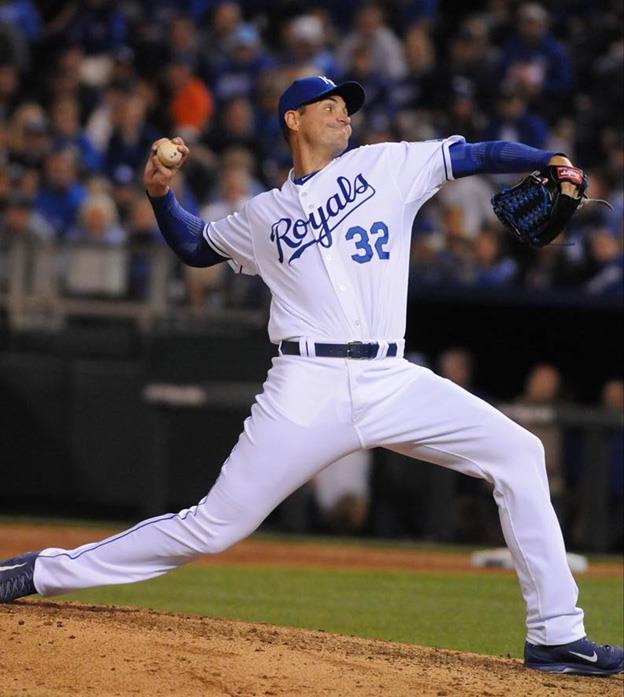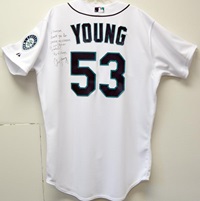
Chris Young, 35, won the American League Comeback Player of the Year Award as a starting pitcher with the Seattle Mariners last season, going 12-9 with a 3.65 ERA. But as the name of the award suggests, he went through a down period – several years, in fact – in which his prospects were not so bright.
Chris’s journey took him to Washington University vascular surgeon Robert Thompson, MD, at Barnes-Jewish Hospital after several years of debilitating shoulder pain, surgeries, and ups and downs in his baseball career.
A 6-foot-10 right-handed pitcher, Chris started his major league career with the Texas Rangers in 2004. He enjoyed his greatest success as a member of the San Diego Padres starting rotation from 2006 to 2009, winning a playoff game against the St. Louis Cardinals in 2006 and playing in the All-Star Game in 2007.
Shoulder pain ended his season early in 2009, as he was placed on the disabled list and underwent arthroscopic surgery. Chris did not rebound in 2010 with the Padres or in 2011 with the New York Mets, making four starts in each season and undergoing an open surgery for a torn anterior capsule in his shoulder. He made 20 starts for the Mets in 2012, but he hit bottom the next spring when he tried out for the Washington Nationals.
“I didn’t make the team,” says Chris. “My hand started getting numb. I had no velocity, no endurance.”
Chris had heard of thoracic outlet syndrome (TOS), but associated it with a lack of pulse and swelling, while his main symptom had been shoulder pain. He talked with the Nationals’ team doctor, who had a relationship with Dr. Thompson.
“When I saw Chris in July 2013,” said Dr. Thompson, “he described intermittent numbness and tingling going down the arm to the fingers, and fatigue and a ‘dead arm’ symptom when he was pitching. So early fatigue when pitching, and after a certain number of throws, maybe 20 or 30, he would get this dead arm feeling and not know where the ball was going.”
Chris’ symptoms fit the pattern of neurogenic TOS. This condition is caused by compression of the brachial plexus nerve roots within the scalene triangle, the space above the collarbone where the two scalene muscles come down from the neck and attach to the first rib.
Chris, who was ready to quit baseball if TOS wasn’t the cause of his problems, agreed to surgery, which Dr. Thompson performed in mid-July.
“We did an approach from above the clavicle to remove the first rib and the two scalene muscles that attached to it,” says Dr. Thompson. “We found scar tissue that had formed around the brachial plexus nerves and we removed the scar tissue and mobilized each of the brachial plexus nerves. Through a small second incision below the collarbone, we released the tendon of the pectoralis minor muscle, as well. And so we opened up the space all the way through the thoracic outlet for the brachial plexus nerves.”
After surgery, Chris’ pain was gone. “I knew that the second I woke up from the surgery,” he says.
Chris and Dr. Thompson attribute the pitcher’s remarkable comeback to his highly disciplined approach to rehabilitation. He started throwing before spring training in 2014 and surprised the Nationals with his overall condition and level of pitching. They had not expected him to be on the team and had to release him when they failed to place him on their roster. Seattle picked him up, and he pitched 165 innings before his arm tired at the end of the season – a result of 13 months of throwing.

This year, Chris signed with the American League Champion Kansas City Royals and is working as a long reliever and starter.
Dr. Thompson says the prognosis is often good for a pitcher with TOS, like Chris or other pitchers who may have had neurogenic or other forms of TOS (arterial or venous).
For Chris, the removal of the first rib and the scalene muscles does not restrict using his arm in virtually any manner. At the same time, a pitcher should avoid poor mechanics he may have developed to compensate for TOS.
“I feel the strength is back 100%,” says Chris. “Without Dr. Thompson, I would have retired.”